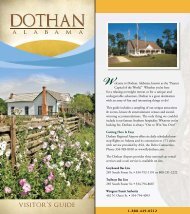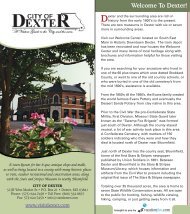PRINT THIS iBROCHURE - VacationFun.com
PRINT THIS iBROCHURE - VacationFun.com
PRINT THIS iBROCHURE - VacationFun.com
Create successful ePaper yourself
Turn your PDF publications into a flip-book with our unique Google optimized e-Paper software.
1<br />
HISTORY<br />
2<br />
3<br />
Historic Walking Tour<br />
4<br />
By historic standards, Telluride is a fairly modern town. The first pioneers didn’t arrive until 1876, and they settled on the Valley Floor, west of<br />
the present town’s site. Once gold was discovered, the boom was on. In a short span of 20 years, the town grew from a hodgepodge of cabins<br />
and shacks to rows of elegant Victorians and stately brick buildings. Businesses on main street were soon decorated with elaborate façades,<br />
many of which remain today. Because of its important contributions to early mining, Telluride was designated as a National Historic Landmark<br />
District in 1964. To protect the town’s Victorian and mining character, Telluride established the Historic and Architectural Review Commission<br />
(HARC). Any new building or remodeling plans must be reviewed and approved by HARC before construction begins. The buildings on this<br />
self-guided tour have withstood the passage of time, although most have been restored. For guided historic tours, see page 56.<br />
1. San Miguel County Courthouse<br />
In 1886, a courthouse was erected on the<br />
south side of West Colorado Avenue. This<br />
building burned shortly after construction, but<br />
the bricks were saved to build the present<br />
courthouse less than a year later on the<br />
opposite corner (Colorado Ave. and Oak St.).<br />
Complete with clock tower, it stands as one of<br />
town’s oldest remaining buildings.<br />
2. New Sheridan Hotel<br />
& Opera House<br />
This Telluride landmark was built in 1895.<br />
For fine dining, the Continental Room had 16<br />
velvet-curtained booths, each equipped with<br />
phones so diners could call for service and not<br />
be interrupted by waiters. The Sheridan Bar<br />
remains much the same with its cherry wood bar<br />
imported from Austria. William Jennings Bryan<br />
delivered a speech, though not his famous<br />
“Cross of Gold,” on a platform in front of the<br />
Sheridan in 1903. The Opera House, a lovely<br />
theater with a Venetian scene painted on its roll<br />
curtain by J. Erickson, was added in 1914.<br />
3. Roma Bar Building<br />
Once one of Telluride’s oldest saloons, this<br />
building contains a period piece downstairs—an<br />
1860 Brunswick-Balke-Collener Company bar<br />
of carved walnut, with exquisite 12-foot French<br />
mirrors on the back bar. The Roma was one of<br />
the wildest and most raucous establishments<br />
in town. It was renovated in 1983 and again in<br />
2006 to be<strong>com</strong>e Honga’s Lotus Petal restaurant.<br />
4. St. Patrick’s Catholic Church<br />
This church was built in 1896 on Catholic Hill<br />
for $4,800. By 1899, it had 200 members. The<br />
wooden figures of the Stations of the Cross<br />
were carved in the Tyrol of Austria.<br />
5. Old Waggoner House<br />
Charles Waggoner, president of the Bank<br />
of Telluride (yellow brick building with pillars<br />
on main street; see E on map), contrived a<br />
scheme purportedly to save his bank in the<br />
Wall Street Crash of 1929. By siphoning money<br />
from New York banks, he possibly kept most<br />
Telluride depositors in the black. Waggoner<br />
testified in court, “I would rather see the New<br />
York banks lose money than the people of<br />
Telluride, most of whom have worked all their<br />
lives for the savings that were deposited in my<br />
bank.” Waggoner was sentenced to 15 years in<br />
prison but was paroled after six years. He never<br />
returned to Telluride. Later tenants included the<br />
Goldsworthy family from 1932 to1988: George<br />
Goldsworthy, born in nearby Rico, Colorado,<br />
grew up to be an astute businessman and<br />
operated the City Bakery and the City Grocery<br />
in the present Telluride Trappings and Toggery<br />
building on main street. George and his wife,<br />
Bessie, raised 10 children in this house.<br />
6. Town Hall<br />
On the corner of Fir and Columbia is<br />
Telluride’s first schoolhouse. This one-room<br />
building was built in 1883 for the sum of $3,000.<br />
The first class held there had 53 students and<br />
one teacher. After a new school was built, the<br />
town offices moved into the building. The tower<br />
for drying fire hoses was added at that time.<br />
24 Telluride & Mountain Village Visitor Guide summer/fall 2009 Make reservations or get information online at www.VisitTelluride.<strong>com</strong><br />
5<br />
7. Telluride Historical Museum<br />
The building itself was built in 1896 by Dr.<br />
Hall and served as a hospital for the miners,<br />
townspeople and county poor. It was renovated<br />
in 2002, and a strong collection of photographs<br />
and artifacts now reconstructs the colorful days<br />
of Telluride’s mining past.<br />
6<br />
8. North Oak House<br />
Built in 1900, this house survived the 1914<br />
flood, when a spring cloudburst caused the<br />
usually gentle Cornet Creek to turn into a<br />
torrent of mud and rocks that swept through<br />
town, depositing five feet of mud and debris<br />
from the Liberty Bell Mine down to Colorado<br />
Avenue. One woman was killed, and the<br />
Sheridan Bar was filled with mud halfway to<br />
the ceiling. This house has been restored to<br />
its original condition, enabling it to be on the<br />
National Register of Historic Homes.<br />
9. Davis House<br />
This stately brick house was built by<br />
E.L. Davis in 1894. Davis was a mining and<br />
real estate entrepreneur and owner of the<br />
Mayflower, Nellie and Etta gold mines in the<br />
Ingram-Bridal Veil Basin and Bear Creek area.<br />
He owned all the land where the former Rio<br />
Grande Southern Train Depot now stands, as<br />
well as one-third interest in West Telluride.<br />
Davis sought to bring business to the town as<br />
vice-president of the Telluride Board of Trade.<br />
After Davis’ death, the house was sold to Dr.<br />
Oshner, who used it as a hospital, particularly<br />
during the 1918 flu epidemic. The house was<br />
renovated in 1983.<br />
10. L.L. Nunn House<br />
This white Victorian was bought by L.L. Nunn<br />
for his Telluride Institute, where “pinheads”<br />
from Cornell University came to expand their<br />
knowledge about the production of power.<br />
Today, Cornell University has a “Telluride<br />
House” funded by Nunn’s estate. Next door, on<br />
the corner of Aspen and Columbia is the house<br />
in which Nunn lived. His home was built in 1887<br />
and remodeled extensively in 1980.<br />
7





